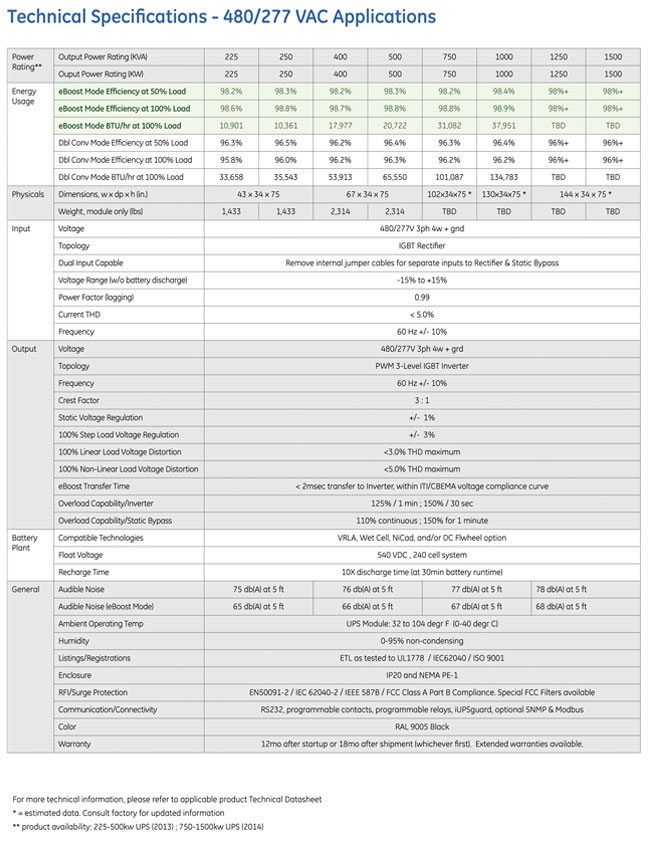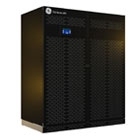
TLE Series UPS 160-1000kW 60Hz/ UL listed
Innovative Technology & Best-in-Class Efficiency
The TLE Series UPS brings the latest power conversion technology to the marketplace, using a three-level inverter design and a multi-mode architecture that makes real time decisions between premium protection mode and premium efficiency mode. The TLE Series UPS was developed using GE's Design for Six Sigma (DFSS) methodology to ensure that the product meets customer requirements for reliability and quality.
| GE Technology at Its Best | |
|---|---|
| Highly reliable and efficient tri-level conversion | |
| Automatic or manual multi-mode generation | |
| "Best of Both Worlds" Operating Efficiency | |
|---|---|
| Up to 99% premium efficiency mode (filtered eBoost) | |
| Up to 97% premium protection mode (double conversion) | |
| Electrical Environment Optimization | |
|---|---|
| Unity (1.0) Output Power Factor | |
| High (0.99) Input Power Factor | |
| Less than 5% Input Current Harmonic Distortion | |
| Physical Environment Optimization | |
|---|---|
| Small footprint | |
| Front access only design for maintenance | |
| "Cable saver" design to allow +/- 25% differential of cable lengths between UPS modules and the output parallel | |
High Efficiency
Energy Efficiency is Our Focus
GE's TLE Series UPS is one of the most energy efficient double-conversion UPS in the industry, and provides world-class energy efficiency across the operating load range. The TLE Series delivers efficiency up to 96.5% in double conversion mode and 99% in eBoost operating mode. This system efficiency substantially reduces operating and cooling costs thus providing a reduced cost of ownership and improved power usage effectiveness (PUE) compared to conventional UPS. GE's UPS performance is optimized at 50-75% load operation, as this is the most common operating range. The optimization of the TLE Series includes selecting all major power chain components based on maximizing the component efficiency at part load conditions.
High Efficiency TLE Series UPS Provides:
- Substantial reduction in operating cost of UPS
- Reduced energy loss minimizes air conditioning requirement
- Energy savings from reduced cooling
eBoost
Energy consumption is a critical issue for IT organizations as their datacenter energy demands continue to grow. Their goal is to reduce cost and keep the datacenter running. IT organizations can reduce energy consumption costs without sacrificing system reliability with GE's eBoost technology
High Efficiency – Data Center Life Cycle Cost Savings
The TLE Series with 96.5 % efficiency in double conversion mode and 99% efficiency in eBoost operating mode provides considerable life cycle cost savings in comparison to a traditional transformer less UPS operating at 94% efficiency. Savings are dependent upon load, power cost and life cycle duration (years). For 6 MW load TLE series provides savings of $2 MM while operating in VFI mode.
Assumptions
- Power Cost = $0.10/kw-hr
- Operating Hrs/Year = 8.760
- Confirmation = S+S operating at 50% of capacity
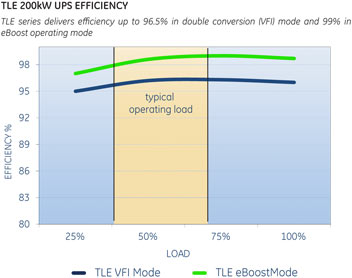
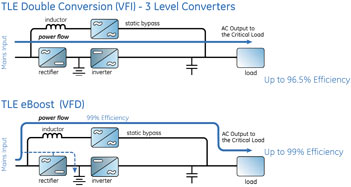
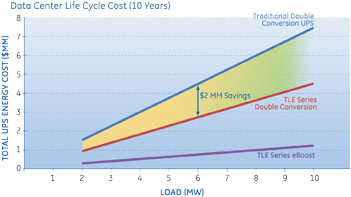
High Performance
Input Performance
Clean Input Performance
The TLE Series IGBT based rectifier and innovative control algorithm helps ensure an input Total Harmonic Distortion (THDi) of less than 3% and draws a pure sinusoidal waveform from the mains. This also provides UPS input power factor of 0.99.
Advantages
- Saving in the sizing of upfront equipment e.g. emergency generators, cablings, and circuit breakers
- No disturbances to nearby equipment; eliminate perturbation and outage on upfront electrical equipment, avoiding also any investigation and analysis cost due to malfunction
Programmable Soft Start
The programmable soft start allows the rectifier to ramp up in a programmable time period (0-15 seconds) thus eliminating in-rush current. This feature reduces the need of oversizing the input power system (gensets, feeder cables, and overcurrent devices).
Generator Compatibility
User-programmable features such as slew rate, phase angle rate-of-change and voltage rate-of-change allow the UPS to quickly sync to a genset during emergency back-up.
Output Performance
Total Harmonic Distortion (THD)
A distorted output voltage waveform affects the proper function of the load's equipment. The TLE Series has very low output voltage THD, even with connected 100% unbalanced or 100% non-linear loads.
Output Power Factor 1
- TLE Series with unity output power factor provides more output power. Output power factor diagram symmetrical with respect to zero. 100% kVA – no derating with any load.
- Suitable for modern power supply application with unit or capacitive power factor (e.g. new servers generation), crest factor up to 3:1.
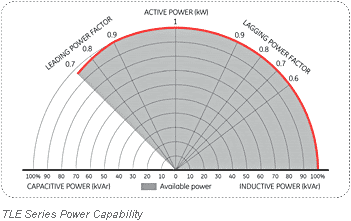
Transient Response
Transient response is very fast due to control algorithms which ensure very high dynamic stiffness. This reduces the need to oversize the UPS for pulse load applications.
Parallel Architecture
Redundant Parallel Architecture™ (RPA) System Configuration
GE provides RPA, a unique technology that can parallel UPS modules with true redundancy by eliminating any single point of failure. RPA provides a scalable paralleling technique that reduces operating footprint and increases system reliability by eliminating the need for external paralleling equipment and cabinets (centralized bypass and master control).
One of the UPS modules in the system intelligently takes the leadership role, while the other UPS modules have access to all control parameters. If one UPS fails to operate, the load is automatically redistributed among the others. If the lead UPS fails to operate, then another UPS automatically takes on the leadership role. GE's RPA technology is implemented by distributing the control electronics within each UPS module in the system.
RPA System Advantages
- No Single Points of Failure
- Bypass Inductor Design
- Scalable and Modular
- Redundant Communication
- Distributed Control Logic
- Online Maintenance
- Sequential Soft Start
- RPA Cable Saver
- Smaller Footprint

Technical Specifications - 415/240 VAC Applications
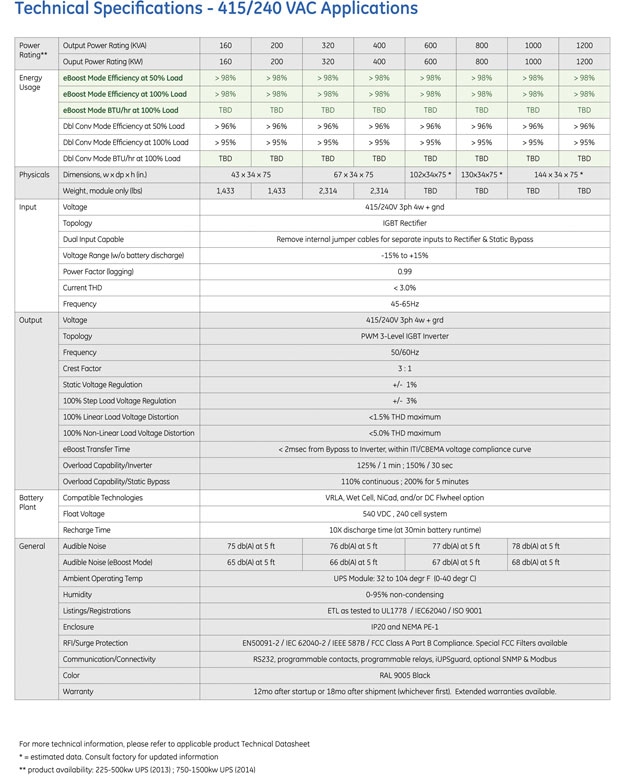
Technical Specifications - 480/277 VAC Applications
